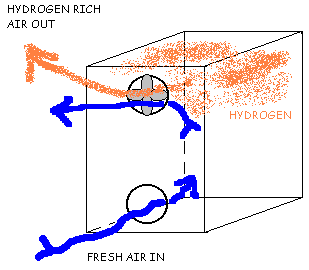HYDROGEN VENTILATION USING A FAN
FIGURE 1 – Hydrogen Ventilation Using an Exhaust Fan and Fresh Air Vent.
A battery enclosure using fan ventilation as shown in Figure 1, must be designed to provide enough fresh air to dilute the hydrogen to a safe level even during runaway battery charger conditions. When a constant fan speed is used, this results in excessive amounts of outside air constantly entering the fresh air vent. When the temperature is too hot or too cold outside, the batteries could be damaged or compromised by the constant exposure to extreme temperatures.
To maintain a safe concentration of hydrogen, the fan must supply 25 times the volume of hydrogen generated under the worst possible conditions. A bank of batteries using a 1 KW charger that fails to shut off can generate 3.4 liters per minute of hydrogen, requiring 85 liters per minute of fresh air to prevent an explosion. This amount of continuous ventilation virtually eliminates the effectiveness of any insulation that may exist in the walls and roof of the enclosure.
The fan is subject to eventual mechanical or electrical failure, and so are any sensors or other fan controls in such a system. It is always possible for the ventilation fan system to fail during thermal runaway conditions. If this does happen, explosive conditions will be the result.

